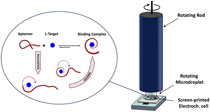Publication
812
Anal. Chem., 88 (23), 11963-11971, 2016
DOI:10.1021/acs.analchem.6b04046
|
|
|
|
|
|
 |
Multi-analytical study of the binding between a small chiral molecule and a DNA aptamer: evidences for asymmetric steric effect upon 3’ vs. 5’-end sequence modification |
|
|
|
Lylian Challier, Rebeca Miranda-Castro, Bertrand Barbe, Claire Fave, Benoit Limoges, Eric Peyrin, Corinne Ravelet, Emmanuelle Fiore, Pierre Labbé, Liliane Coche-Guerente, Eric Ennifar, Guillaume Bec, Philippe Dumas, Francois Mavré, and Vincent Noël
ITODYS, UMR 7086 CNRS, Université Paris Diderot, Sorbonne Paris Cité, 15 rue Jean-Antoine de Baïf, F-75205 Paris Cedex 13, France
Laboratoire d’Electrochimie Moléculaire, UMR 7591 CNRS, Université Paris Diderot, Sorbonne Paris Cité, 15 rue Jean-Antoine de Baïf, F-75205 Paris Cedex 13, France
Département de Pharmacochimie Moléculaire, UMR 5063 CNRS, Université Grenoble Alpes, 470 rue de la chimie, 38400 Saint-Martin d’Hères, France
Département de Chimie Moléculaire, CNRS, UMR 5250, Université Grenoble Alpes, FR 2607, 570 rue de la chimie, B.P. 53, 38400 Grenoble, France
“Architecture et Réactivité de l’ARN”, Biophysique et Biologie Structurale, Institut de Biologie Moléculaire et Cellulaire du CNRS, Université de Strasbourg, 15 rue René Descartes, 67084 Strasbourg, France
Nucleic acid aptamers are involved in a broad field of applications ranging from therapeutics to analytics. Deciphering the binding mechanisms between aptamers and small ligands is therefore crucial to improve and optimize existing applications and to develop new ones. Particularly interesting is the enantiospecific binding mechanism involving small molecules with nonprestructured aptamers. One archetypal example is the chiral binding between l-tyrosinamide and its 49-mer aptamer for which neither structural nor mechanistic information is available. In the present work, we have taken advantage of a multiple analytical characterization strategy (i.e., using electroanalytical techniques such as kinetic rotating droplet electrochemistry, fluorescence polarization, isothermal titration calorimetry, and quartz crystal microbalance) for interpreting the nature of binding process. Screening of the binding thermodynamics and kinetics with a wide range of aptamer sequences revealed the lack of symmetry between the two ends of the 23-mer minimal binding sequence, showing an unprecedented influence of the 5′ aptamer modification on the bimolecular binding rate constant kon and no significant effect on the dissociation rate constant koff. The results we have obtained lead us to conclude that the enantiospecific binding reaction occurs through an induced-fit mechanism, wherein the ligand promotes a primary nucleation binding step near the 5′-end of the aptamer followed by a directional folding of the aptamer around its target from 5′-end to 3′-end. Functionalization of the 5′-end position by a chemical label, a polydA tail, a protein, or a surface influences the kinetic/thermodynamic constants up to 2 orders of magnitude in the extreme case of a surface immobilized aptamer, while significantly weaker effect is observed for a 3′-end modification. The reason is that steric hindrance must be overcome to nucleate the binding complex in the presence of a modification near the nucleation site. |

